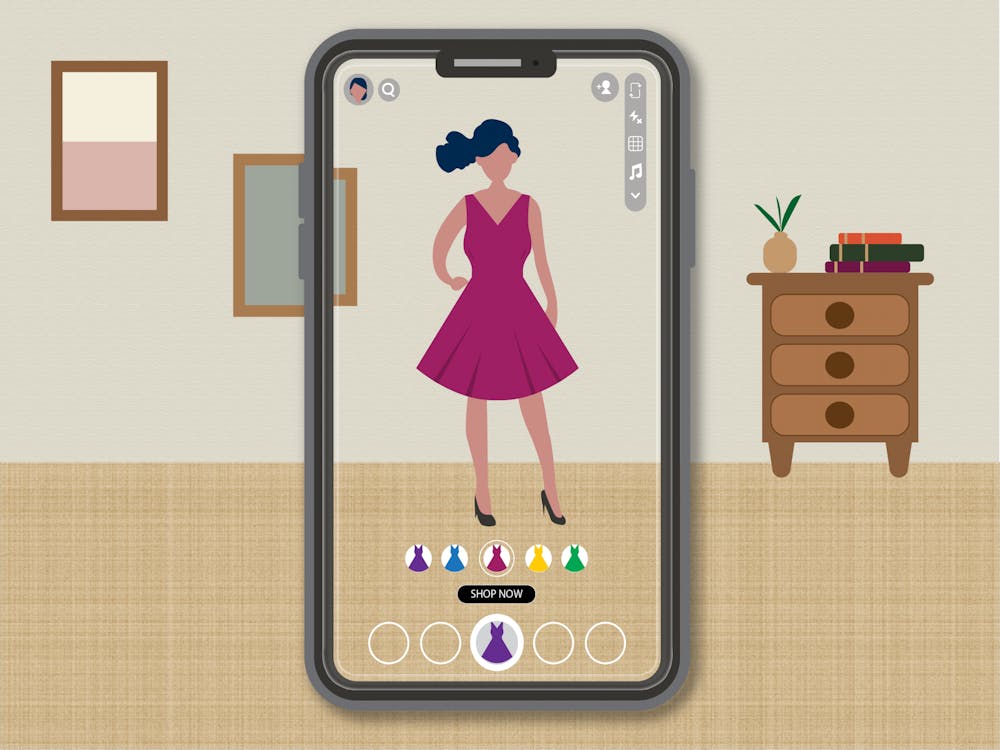Cellphones are evolving into a one-stop shop for everything we could possibly need. While it's still common to buy clothes in a brick-and-mortar store, online shopping is more popular than ever.
With technology evolving, the days of driving to a store, patiently waiting for a fitting room and standing in front of a mirror can be simplified through your cellphone. Opening up a package and feeling disappointed as the item doesn't fit properly or appears different than promised can now be avoided.
Newsflash, your smart phone can be the new mall; you can try on clothing, shoes, glasses and beauty products through a single click!
At least that’s what Snapchat is arguing.
Snapchat’s newest feature, "Shopping Lenses" attempts to reinvent the fitting room experience through Augmented Reality (AR). Certain virtual fitting rooms use AR to take body measurements and create full-body 3D models of the shopper. The software then fits the clothes onto the body so that shoppers can see the item without the need to physically try it on.
However, "Shopping Lenses" works a little differently. Users can take a picture of themselves, and the app will overlay the clothing articles over the user's body. The app gives a feature to allow individuals to buy the item after they try it on.
Even USC students without the Snapchat app have thoughts on the try-on filter. “When you buy stuff online, you just look at the picture on a model, and so by being able to put it [product filters] over yourself, you would have a better impression of what the item would look like on you,” USC sophomore Maya McCune said.
According to Snapchat for Business, “Snapchatters who experience a shoppable AR Lens are 2.4 times more likely to purchase than those who do not.”
A study by Snapchat indicated that allowing customers to use AR to browse for items has led to a 25% decrease in returns. Not only does this technology allow you to skip the awkwardness and hassle of using dressing rooms, but it reduces waste in the forms of returns and the sanitary hurdles of testing beauty products.
With all of these supposed benefits, is this try-on filter really a staple among USC students?
“It [the filter] hasn’t changed how I look at makeup or anything. I wouldn’t say it has made me go out and invest in them; but I do like those brands,” USC freshman Sarah Hrivnik said. “I just think those filters, they haven’t really done anything for me.”
While there are online fitting room options, most of the interviewed students advocate for brick-and-mortar fitting rooms. The primary motivation for championing physical stores' fitting rooms is the need to see, touch and feel the items. As of 2017, 62% of shoppers preferred shopping in-store because they are able to connect physically with the clothing through utilizing their senses.
Lack of trust is also a major contender in why these USC students prefer online shopping to Snapchat's shopping experience. “I am more a 'go into a store' person or 'online shopping' type of person,” said USC freshman Olivia Bollchoz. “I don’t think I would ever buy anything from Snapchat just because I don’t really trust it. I feel like when people buy things off Snapchat or Instagram, they don’t come in as good quality in comparison to buying it from somewhere else.”
“There’s a filter try-on where they [Snapchat] will insert sunglasses on you,” USC sophomore Celine Nguyen said. “I think the try-on filters are funny, silly and fun to play around with but…I don’t find those try-on filters as something I would actually buy.”
Beyond the lack of trust and accountability, these USC students feel that Snapchat wasn't made to be a retail commerce platform and thus they will not treat it as such.
“I never think about it [the filters] as, ‘Oh, I want to buy this...’ It is more just messing around with the filters,” Nguyen said.
“To me, they [the filters] are ads for L’Oreal, Maybelline, or Covergirl...and usually they make me look really funny,” Hrivnik said.
“I like fitting rooms because I think the experience of actually seeing it [clothes] on my body, it makes me actually want to buy it rather than if I’m just doing it online. I’m just like, 'I don’t know how it will actually look,'” Hrivnik said. "The experience of using a fitting room is fun and I am more likely to buy it."
Yet despite these sentiments, it was predicted by Valuates Reports that the global virtual fitting room market will grow from $4.03 billion in 2022 to $14.87 billion by 2029.
So what's driving the lag on USC's campus?
“It’s not in our human nature to scan ourselves," said Beth Esponnette, founder of digital apparel startup Unspun. "Certainly, we haven’t grown up with that. We’re used to walking into a store, and all the products are there already."
Unless USC students adapt to a new mindset, abandoning the need to touch and feel the clothing, Snapchat will continue to serve only one purpose: keeping USC students connected with one another.
To use the try-on clothing, beauty or accessory feature, go to Snapchat’s Lens Explorer and then tap ‘Dress Up’ in the upper left-hand corner. Feeling like you want to wear that item IRL? Click the ’Shop Now’ button which will take you directly to the brand’s website.



